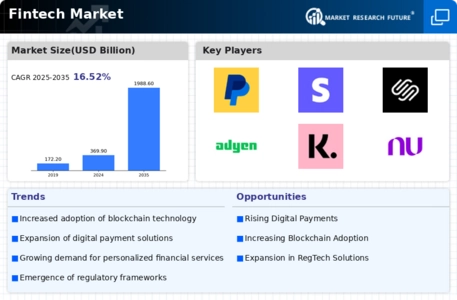Rise of Mobile Banking Solutions
The Fintech Market experiences a notable rise in mobile banking solutions, driven by the increasing penetration of smartphones and the demand for convenient banking services. As of 2025, it is estimated that over 70 percent of consumers utilize mobile banking applications, reflecting a shift towards digital-first financial services. This trend is further supported by advancements in mobile technology, enabling secure transactions and real-time account management. Financial institutions are increasingly investing in mobile platforms to enhance customer engagement and streamline operations. The proliferation of mobile banking not only caters to tech-savvy consumers but also addresses the needs of underserved populations, thereby expanding the reach of financial services. Consequently, the Fintech Market is likely to witness sustained growth as mobile banking becomes a cornerstone of modern financial interactions.
Emergence of Blockchain Technology
Blockchain technology is emerging as a transformative force within the Fintech Market, offering enhanced security, transparency, and efficiency in financial transactions. The decentralized nature of blockchain allows for peer-to-peer transactions without the need for intermediaries, which could potentially reduce costs and transaction times. As of 2025, the adoption of blockchain solutions is projected to increase significantly, with a growing number of financial institutions exploring its applications in areas such as cross-border payments, smart contracts, and identity verification. This technology not only enhances trust among users but also mitigates risks associated with fraud and data breaches. The Fintech Market is likely to evolve as blockchain becomes integral to various financial services, fostering innovation and creating new business models.
Regulatory Support for Fintech Innovations
Regulatory support plays a crucial role in shaping the Fintech Market, as governments worldwide recognize the potential of fintech innovations to drive economic growth and enhance financial stability. In 2025, several jurisdictions are expected to implement favorable regulations that promote fintech development while ensuring consumer protection. Initiatives such as regulatory sandboxes allow fintech companies to test their products in a controlled environment, fostering innovation without compromising regulatory standards. This supportive regulatory landscape encourages investment in fintech startups and facilitates collaboration between traditional financial institutions and fintech firms. As a result, the Fintech Market is likely to experience accelerated growth, with a diverse range of financial solutions emerging to meet evolving consumer needs.
Expansion of Peer-to-Peer Lending Platforms
The expansion of peer-to-peer lending platforms is reshaping the Fintech Market, providing alternative financing options for individuals and small businesses. These platforms connect borrowers directly with lenders, bypassing traditional financial institutions and often resulting in lower interest rates and more accessible credit. As of 2025, the peer-to-peer lending market is projected to grow significantly, driven by increasing consumer awareness and the desire for flexible financing solutions. This trend is particularly beneficial for underserved segments of the population who may struggle to obtain loans from conventional banks. The rise of peer-to-peer lending not only democratizes access to credit but also fosters a sense of community among lenders and borrowers, thereby enhancing the overall financial ecosystem.
Growing Demand for Personalized Financial Services
The demand for personalized financial services is rapidly increasing within the Fintech Market, as consumers seek tailored solutions that cater to their unique financial situations. Advances in data analytics and artificial intelligence enable fintech companies to offer customized products and services, enhancing customer satisfaction and loyalty. By leveraging consumer data, fintech firms can provide insights and recommendations that align with individual financial goals. As of 2025, it is anticipated that personalized financial services will account for a substantial portion of the fintech market, with consumers increasingly gravitating towards platforms that offer bespoke solutions. This trend not only benefits consumers but also drives competition among fintech providers, leading to continuous innovation and improvement in service offerings.

















Leave a Comment